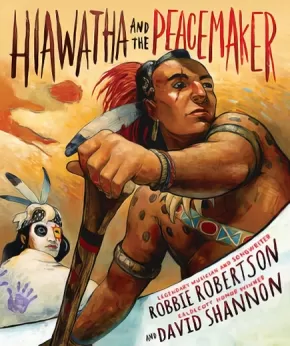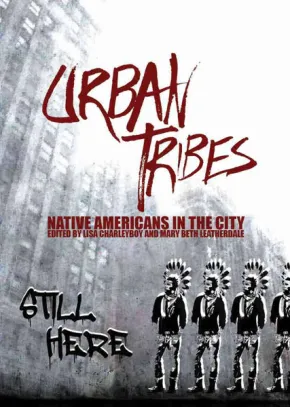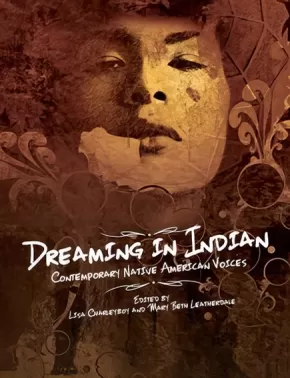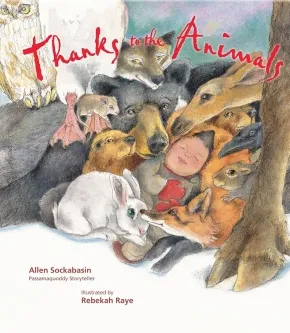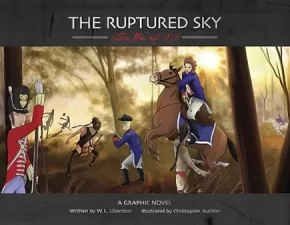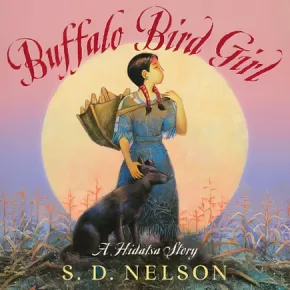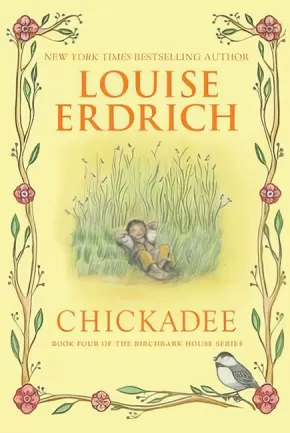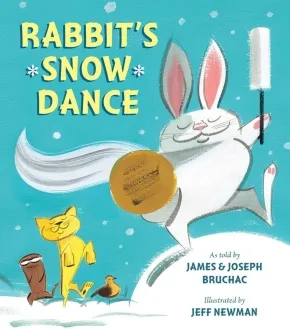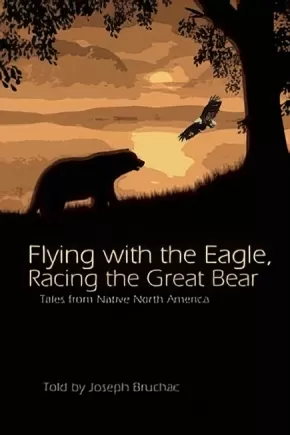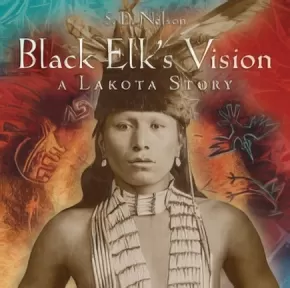
Indigenous Peoples in the United States
301
-
315
of
343 Results;
Sort By
Go To
of 23
Hiawatha and the Peacemaker
$25.99
Artists:
Format:
Hardcover
Text Content Territories:
Indigenous Canadian; First Nations; Haudenosaunee (Iroquois);
ISBN / Barcode: 9781419712203
Synopsis:
Synopsis:
Born of Mohawk and Cayuga descent, musical icon Robbie Robertson learned the story of Hiawatha and his spiritual guide, the Peacemaker, as part of the Iroquois oral tradition. Now he shares the same gift of storytelling with a new generation.
Hiawatha was a strong and articulate Mohawk who was chosen to translate the Peacemaker’s message of unity for the five warring Iroquois nations during the 14th century. This message not only succeeded in uniting the tribes but also forever changed how the Iroquois governed themselves—a blueprint for democracy that would later inspire the authors of the U.S. Constitution.
Caldecott Honor–winning illustrator David Shannon brings the journey of Hiawatha and the Peacemaker to life with arresting oil paintings. Together, Robertson and Shannon have crafted a new children’s classic that will both educate and inspire readers of all ages.
Includes a CD featuring a new, original song written and performed by Robbie Robertson.
Additional Information
48 pages | 9.50" x 11.25"
In the Footsteps of Crazy Horse (4 in stock, in reprint)
$23.99
Artists:
Format:
Hardcover
Text Content Territories:
Indigenous American; Native American; Sioux; Lakota;
ISBN / Barcode: 9781419707858
Synopsis:
Synopsis:
Through stories of Lakota leader Crazy Horse, a boy learns about his heritage and himself in this American Indian Youth Literature Award-winning novel from acclaimed author Joseph Marshall III.
Jimmy McClean is a Lakota boy, though you wouldn’t guess it by his name. His mother is Lakota, and his father is half white and half Lakota. Over summer break, Jimmy embarks on a journey with his grandfather, Nyles High Eagle. While on the road, his grandfather tells him the story of Crazy Horse, one of the most important figures in Lakota, and American, history.
Expertly intertwining fiction and nonfiction, celebrated Brulé Lakota author Joseph Marshall III chronicles the many heroic deeds of Crazy Horse, especially his taking up arms against the U.S. government. He fiercely fought against encroachments on the territories and way of life of the Lakota people, including leading a war party to victory at the Battle of the Greasy Grass (the Battle of the Little Bighorn) and playing a major and dangerous role as decoy at the Battle of the Hundred in the Hands (the Fetterman Battle). With Sitting Bull, Crazy Horse was the last of the Lakota to surrender his people to the U.S. Army. Through his grandfather’s tales about the famous warrior, Jimmy learns about his Lakota heritage and, ultimately, himself.
Drawing references and inspiration from the oral stories of the Lakota tradition, Marshall gives readers an insider’s perspective on the life of Tasunke Witko, better known as Crazy Horse.
Reviews
"This powerful introduction to a great warrior and leader invites readers to ponder the meaning of 'hero.'"— Kirkus Reviews
"As Jimmy and his grandfather’s journey comes to an end, the boy has gained much more than a history lesson—he learns a great deal about courage, sacrifice, and the ties that connect him to his ancestors. VERDICT A moving narrative that should be required reading for all students of American history." — School Library Journal
“It provides insights and stories that you don't get from academic historians…There is nothing like it.” — Debbie Reese, American Indians in Children's Literature
Educator Information
Recommended for ages 10 to 14.
Recommended for ages 10 to 14.
Additional Information
176 pages | 6.20" x 8.25" | Black and White Illustrations | Hardcover
The Apple Tree (2 in Stock, Out of Print)
$26.95
Artists:
Format:
Hardcover
Text Content Territories:
Indigenous American; Native American; Cherokee;
ISBN / Barcode: 9781937054038
Synopsis:
Synopsis:
A Cherokee boy plants an apple seed, and as soon as a seedling appears he can see the apple tree it is meant to be. But the little apple tree isn't so sure. Young and impatient, it begins to doubt its calling, especially after apples fail to appear that first fall. How can the boy convince the tree to give the seasons the time to work their magic?
Story in English with Cherokee translation.
Urban Tribes: Native Americans in the City
$14.95
Editors:
Format:
Paperback
Text Content Territories:
Indigenous Canadian; Indigenous American;
ISBN / Barcode: 9781554517503
Synopsis:
Synopsis:
The majority of Natives in North America live "off the rez." How do they stay rooted to their culture? How do they connect with their community?
Urban Tribes offers unique insight into this growing and often misperceived group. This anthology profiles young urban Natives and how they connect with Native culture and values in their contemporary lives.
Their stories are as diverse as they are. From a young Dene woman pursuing an MBA at Stanford University to a Pima photographer in Phoenix to a Mohawk actress in New York City, these urban Natives share their unique insight to bridge the divide between their past and their future, their cultural home, and their adopted cities.
Unflinchingly honest and deeply moving, the contributors explore a wide range of topics: from the trials and tribulations of dating in the city to the alienating experience of leaving a remote reserve to attend high school in the city, from the mainstream success of the Electric Pow Wow music genre to the humiliation of racist school mascots.
Each of the personal perspectives helps to illuminate larger political issues. An innovative and highly visual design offers a dynamic reading experience.
Educator Information
Recommended Ages: 11 - 18.
Recommended Authentic First Peoples resource.
Recommended English First Peoples resource.
Additional Information
136 pages | 6.75" x 9.50" | colour illustrations and photographs, foreward, introduction, bibliography
Wisdom from our First Nations
$10.95
Format:
Paperback
Text Content Territories:
Indigenous American; Indigenous Canadian;
ISBN / Barcode: 9781927583555
Synopsis:
Synopsis:
In Indigenous cultures, elders serve as a bridge across time: they are connected to the past, they live in the present and they offer wisdom for the future. In these fascinating biographical essays, twelve First Nation and Native American elders share stories from their lives and tell what it was like to live in a time before television, cell phones and video games. Their stories explain how their humble childhoods shaped the adults they became and the lessons they share as elders. All the elders profiled work to ensure that their Native culture is passed down to members of their tribe. Settle in with this book and “listen” to the stories of these elders’ lives. As you take in their history, you just might gain wisdom that could make a difference in your own life.
Educator & Series Information
This book is part of the First Nations Series for Young Readers. Each book is a collection of biographies of First Nations, Métis, and Inuit women and men who are leaders in their fields of work, in their art, and in their communities.
For ages 9-14.
Additional Information
128 pages | 6.00" x 9.00"
Dreaming in Indian: Contemporary Native American Voices
$19.95
Artists:
Editors:
Format:
Hardcover
Text Content Territories:
Indigenous American; Indigenous Canadian;
ISBN / Barcode: 9781554516872
Synopsis:
Synopsis:
A powerful and visually stunning anthology from some of the most groundbreaking Native artists working in North America today.
Truly universal in its themes, Dreaming In Indian will shatter commonly held stereotypes and challenge readers to rethink their own place in the world. Divided into four sections, ‘Roots,’ ‘Battles,’ ‘Medicines,’ and ‘Dreamcatchers,’ this book offers readers a unique insight into a community often misunderstood and misrepresented by the mainstream media.
Emerging and established Native artists, including acclaimed author Joseph Boyden, renowned visual artist Bunky Echo Hawk, and stand-up comedian Ryan McMahon, contribute thoughtful and heartfelt pieces on their experiences growing up Indigenous, expressing them through such mediums as art, food, the written word, sport, dance, and fashion. Renowned chef Aaron Bear Robe, for example, explains how he introduces restaurant customers to his culture by reinventing traditional dishes. And in a dramatic photo spread, model Ashley Callingbull and photographer Thosh Collins reappropriate the trend of wearing ‘Native’ clothing.
Whether addressing the effects of residential schools, calling out bullies through personal manifestos, or simply citing hopes for the future, Dreaming In Indian refuses to shy away from difficult topics. Insightful, thought-provoking, and beautifully honest, this book will to appeal to young adult readers. An innovative and captivating design enhances each contribution and makes for a truly unique reading experience.
Reviews
“It’s hard to imagine a middle- or high-school classroom that wouldn’t benefit from having this.” —Booklist, 02/15
“Belongs in every middle school, high school and public library.” —CM Reviews, 05/22/15
"For some time now, I've been waiting for Dreaming in Indian: Contemporary Native American Voices... It was getting buzz in Native networks on social media. I've read it, now, and highly recommend it... Dreaming in Indian has a vibrancy I've not seen in anything else. A vibrancy that, perhaps, is characteristic of a generation at ease with technology and its tools... I want to pore over the art, studying it, thinking about it, marveling at it. I can imagine a lot of people dismissing this work because it doesn't conform to their stereotypical ideas of dead or stoic Indians. But I can also imagine a lot of others holding it dear because it reflects who we are... You'll also have a solid introduction to the artists and writers, their lives, what drives them... Gritty and real, their live stories are inspiring... There's a lot to ponder in Dreaming In Indian. It'll challenge readers, in good ways, and that is a good thing. Check it out." — Debbie Reese, American Indians in Children's Literature, September 2014
Educator Information
Recommended Ages: 11-18
Themes: First Nations; native peoples; Indigenous; biography; multicultural; stereotyping; acceptance; community; prejudice; self-esteem; tolerance.
Fountas & Pinnell Reading Level: Z+
Authentic First Peoples resource K-9.
Recommended English First Peoples resource.
Additional Information
128 pages | 8.50" x 11.00" | full-color illustrations and photographs throughout, foreword, introduction
Thanks to the Animals: 10th Anniversary Edition
$24.95
Artists:
Format:
Hardcover
Text Content Territories:
Indigenous American; Native American; Passamaquoddy (Peskotomuhkati);
ISBN / Barcode: 9780884484141
Synopsis:
Synopsis:
Little Zoo Sap and his family are moving from their summer home on the coast to their winter home in the deep woods. Unnoticed, the youngster tumbles off the end of the sled. Alone and frightened, Zoo Sap cries, and his cries attract the forest animals. Beginning with beaver and ending with the great bald eagle, the animals protect the baby and shelter him from the cold until his father comes to get him.
The new edition includes an author's note explaining the seasonal movement of the Passamaquoddy people and a pronunciation guide to the Passamaquoddy names of the animals in the story.
Educator Information
Recommended for ages 6 to 11.
Additional Information
64 pages | 9.00" x 10.00"
Ruptured Sky: The War of 1812
$30.00
Artists:
Format:
Paperback
Text Content Territories:
Indigenous American; Indigenous Canadian;
ISBN / Barcode: 9780132804738
Synopsis:
Synopsis:
The Ruptured Sky explores the War of 1812 from First Nations perspectives. Without their involvement, the borders of Canada and America might have been vastly different.
Without their First Nations allies, British troops and Canadian militia would not have win key battles and the U.S./Canada border might not exist. Canada might not have become an independent nation. First Nations peoples remained conflicted about whom to support since longstanding allegiances existed with both the British and Americans. This became a divisive issue. Individuals such as Tecumseh, John Norton, Joseph Brant, and others played major roles in the war's outcome. First Nations peoples fought with outstanding bravery, great ferocity, and remarkable skill. This book tells a little-known story of their remarkable contributions to Canadian victories in the War of 1812--and of how they were treated at the war's end.
Additional Information
62 pages
Buffalo Bird Girl: A Hidatsa Story
$27.95
Artists:
Format:
Hardcover
Text Content Territories:
Indigenous American; Native American; Three Affiliated Tribes; Hidatsa;
ISBN / Barcode: 9781419703553
Synopsis:
Synopsis:
"I was born in an earth lodge by the mouth of the Knife River, in what is now North Dakota, three years after the smallpox winter." - Buffalo Bird Woman
Born in the 1830s, Buffalo Bird Girl was a member of the Hidatsa people, a Native American community that lived in permanent villages along the Missouri River on the Great Plains. Like other girls her age, Buffalo Bird Girl learned the ways of her people through watching, listening and then doing. She helped plant crops in the spring, tended the fields through the summer - scaring off birds and other animals, as well as hungry boys! - and in autumn joined in the harvest. She also learned to prepare animal skins, dry meat and perform other household duties. Along with her chores, however, there was time for playing games with friends or training her dog. Her family also visited the nearby trading post, where all sorts of magnificent things from the white man's settlements in the East could be seen.
Interweaving the actual words and stories of Buffalo Bird Woman with his artwork and archival photographs, award-winning author and artist S.D. Nelson has woven a poignant yet vibrant story, beautifully capturing the spirit of Buffalo Bird Girl and her lost way of life. The book includes a historical timeline.
Reviews
"The extraordinary illustration of this handsome volume begins with the endpaper maps and features acrylic paintings of the Hidatsa world reminiscent of traditional Plains Indian art. Pencil drawings and relevant, carefully labeled photographs round out the exquisite design. All the artwork both supports and adds to the text. An extensive author’s note and timeline supplement this beautiful tribute." —Kirkus Reviews, starred review
"Nelson's quiet, respectful tone capably balances the factual details of daily life in the Hidatsa tribe with the obvious joy and nostalgia Buffalo Bird Girl feels toward her childhood." —The Bulletin of the Center for Children's Books
"As a writer, storyteller, and traditional artist of the Sioux people, his perspective is genuine and effectively portrayed. This book would be enjoyable for anyone interested in history, but would also be an effective resource in the classroom to support the curriculum.”—Library Media Connection
"Nelson's acrylic paintings and b&w pencil drawings are intriguingly interlaced with the photographs, contrasting Native American figures in blunt profile with harvest colors and background textures that mimic dried spears of grass, leather skins, and basket weaves." — Publishers Weekly"
Educator Information
This fascinating picture book biography tells the childhood story of Buffalo Bird Woman. Through her true story, readers will learn what it was like to be part of this Native American community that lived along the Missouri River in the Dakotas, a society that depended more on agriculture for food and survival than on hunting. Children will relate to Buffalo Bird Girl’s routine of chores and playing with friends, and they will also be captivated by her lifestyle and the dangers that came with it.
Recommended Ages: 6-10
Additional Information
56 pages | 10.50" x 10.25"
Chickadee
$9.99
Artists:
Format:
Paperback
Text Content Territories:
Indigenous American; Native American; Anishinaabeg; Ojibwe (Chippewa);
ISBN / Barcode: 9780060577926
Synopsis:
Synopsis:
Winner of the Scott O'Dell Award for Historical Fiction, Chickadee is the first novel of a new arc in the critically acclaimed Birchbark House series by New York Times bestselling author Louise Erdrich.
Twin brothers Chickadee and Makoons have done everything together since they were born—until the unthinkable happens and the brothers are separated.
Desperate to reunite, both Chickadee and his family must travel across new territories, forge unlikely friendships, and experience unexpected moments of both unbearable heartache and pure joy. And through it all, Chickadee draws from the strength of his namesake, the chickadee, to carry him home.
Chickadee continues the story of one Ojibwe family's journey through one hundred years in America. In a starred review, School Library Journal proclaimed, "Readers will be more than happy to welcome little Chickadee into their hearts."
The paperback edition includes additional material, such as an interview with the author and activities. This story of Chickadee and his family is based on Louise Erdrich’s own family history.
Educator & Series Information
This is the fourth book in the Birchbark House Series, a series of Indigenous juvenile fiction novels written by Ojibwe writer Louise Erdrich.
The books in this series in order include:
The Birchbark House
The Game of Silence
The Porcupine Year
Chickadee
Makoons
Additional Information
224 pages | 5.12" x 7.62"
Great Writers from our First Nations
$10.95
Format:
Paperback
Text Content Territories:
Indigenous American; Indigenous Canadian;
ISBN / Barcode: 9781926920856
Synopsis:
Synopsis:
A celebration of ten writers who have challenged stereotypes, told history from a perspective often silenced, and entertained millions of readers.
Included is author Louise Erdrich, whose novel Love Medicine was the first in an award-winning series about the lives of several generations of Ojibwa families. Sherman Alexie, author of the semi-autobiographical The Absolutely True Diary of a Part-Time Indian, went on to win the National Book Award. Tomson Highway broke new ground with his play The Rez Sisters. Joseph Boyden based his novel Three Day Road in part on his grandfather’s experience fighting in the First World War. N. Scott Momaday re-wrote the history of the American West with his book House Made of Dawn. Nicola Campbell drew on her family’s experience of residential schools to write the children’s books Shi-shi-etko and Shin-chi’s Canoe. Also included are Marilyn Dumont (A Really Good Brown Girl), Tim Tingle (Walking the Choctaw Road), Joseph Bruchac (Buffalo Song), and Maria Campbell (Half-breed).
The full list of writers profiled:
• Sherman Alexie (Spokane/Coeur d’Alene, Washington) - The Absolutely True Diary of a Part-Time Indian
• Louise Erdrich (Ojibwa, North Dakota) - Love Medicine (the Argus Series)
• Joseph Boyden (Cree/Métis, Ontario) - Three Day Road
• N. Scott Momaday (Kiowa/Cherokee, Oklahoma) - House Made of Dawn
• Marilyn Dumont (Cree/Métis, Alberta) - A Really Good Brown Girl
• Tomson Highway (Cree, Manitoba) - The Rez Sisters
• Joseph Bruchac (Abenaki, New York State) - Buffalo Song
• Maria Campbell (Métis, Saskatchewan) - Halfbreed
• Nicola Campbell (Interior Salish/Métis, Alberta) - Shin-chi’s Canoe
• Tim Tingle (Choctaw, Texas) - Walking the Choctaw Road
Educator & Series Information
This book is part of the First Nations Series for Young Readers. Each book is a collection of biographies of First Nations, Métis, and Inuit women and men who are leaders in their fields of work, in their art, and in their communities.
For ages 9-14.
Additional Information
128 pages | 6.00" x 9.00"
Rabbit's Snow Dance
$25.99
Artists:
Format:
Hardcover
Text Content Territories:
Indigenous American; Native American; Haudenosaunee (Iroquois);
Grade Levels: Preschool; Kindergarten;
ISBN / Barcode: 9780803732704
Synopsis:
Synopsis:
A hip and hilarious fable perfect for wintertime
Rabbit loves the winter. He knows a dance, using a traditional Iroquois drum and song, to make it snow--even in springtime! The other animals of the forest don't want early snow, but Rabbit doesn't listen to them. Instead, he sings and dances until more and more snow falls. But how much snow is too much, and will Rabbit know when to stop?
This stylish and oh-so-funny story is a modern take on a traditional Native American fable from master storytellers Joseph and James Bruchac.
Additional Information
|
Environmentalists from our First Nations
$10.95
Format:
Paperback
Text Content Territories:
Indigenous American; Indigenous Canadian;
ISBN / Barcode: 9781897187982
Synopsis:
Synopsis:
Like the other books in the First Nations Series for Young Readers, this book offers ten short and engaging biographies of First Nations/Native activists who advocate not only for the environment but for Native rights. Their stories are full of highs and lows, triumphs and setbacks. Environmental trailblazers, these men and women are role models for children everywhere.
The men and women profiled here are united by their work to protect the environment and to support indigenous rights. Their stories take us from the Arctic National Wildlife Refuge in Alaska to the Black Mesa in Arizona.
Melina Laboucan-Massimo uses her passion to stop oil extraction in Alberta’s tar sands.
Winona LaDuke is a voice for reclaiming Native lands, advocating renewable energy resources, and protecting Native cultures.
Clayton Thomas-Muller is a dynamic advocate for indigenous self-determination and campaigner against tar sands extraction.
Ben Powless brings his youthful energy and skills to addressing climate change issues.
Tom Goldtooth protects sacred sites and organizes global direct-action campaigns for the environment.
Grace Thorpe is a grandmother who dedicated her retirement years to keeping Native reservations from becoming nuclear waste dumps.
Sarah James is a voice from northern Alaska defending the Porcupine caribou herd and the Arctic National Wildlife Refuge.
Enei Begaye & Evon Peter are married activists who work as a team on environmental issues and sustainable strategies for Native people.
Klee Benally uses the media to empower Native communities in their fight for environmental justice.
Teague Allston works to ensure a tribal voice is heard in Washington DC.
Reviews
"These short biographies of environmentalists are sure to engage a whole classroom of readers. From the focus on a particular environmental crisis, to a description of each person's native heritage, to the writing style and level, the stories are accessible to readers young and old." — Canadian Teacher Magazine, March 2012
Educator & Series Information
This book is part of the First Nations Series for Young Readers. Each book is a collection of biographies of First Nations, Métis, and Inuit women and men who are leaders in their fields of work, in their art, and in their communities. For ages 9-14.
Additional Information
128 pages | 6.00" x 9.00"
Flying With the Eagle, Racing the Great Bear: Tales From Native North America
$12.95
Format:
Paperback
Text Content Territories:
Indigenous American; Indigenous Canadian;
ISBN / Barcode: 9781555916930
Synopsis:
Synopsis:
Flying with the Eagle, Racing the Great Bear is a continent-spanning collection of 16 thrilling tales in which young Native American men must face great enemies, find strength and endurance within themselves to succeed, and take their place by the side of their elders.
Additional Information
144 pages | 6.00" x 8.90"
Black Elk's Vision: A Lakota Story
$27.95
Artists:
Format:
Hardcover
Text Content Territories:
Indigenous American; Native American; Sioux; Lakota; Oglala Lakota;
ISBN / Barcode: 9780810983991
Synopsis:
Synopsis:
Told from the Native American point of view, Black Elk’s Vision provides a unique perspective on American history. From recounting the visions Black Elk had as a young boy, to his involvement in the battles of Little Big Horn and Wounded Knee, as well as his journeys to New York City and Europe with Buffalo Bill’s Wild West Show, this biographical account of Black Elk—an Oglala-Lakota medicine man (1863–1950)—follows him from childhood through adulthood.
S. D. Nelson tells the story of Black Elk through the medicine man’s voice, bringing to life what it was like to be Native American in the mid-to-late nineteenth century and early twentieth century. The Native people found their land overrun by the Wha-shi-choos, or White Man, the buffalo slaughtered for sport and to purposely eliminate their main food source, and their people gathered onto reservations. Through it all, Black Elk clung to his childhood visions that planted the seeds to help his people—and all people—understand their place in the circle of life. The book includes archival images, a timeline, a bibliography, an index, and Nelson’s signature art.
Reviews
“A fine choice for story hours, this will also find wide curricular use.” —Booklist
“A modern-day story in the Sioux tradition of storytelling.” —Winston-Salem Journal
“Splendid acrylic artwork captures the action, humor, and spirit of the tale. A solid addition to collections of Native American tales and an enjoyable read-aloud.” —School Library Journal
“Nelson pulls it off with his confident style as a storyteller . . . polished illustrations . . . informative, well written.” —Kirkus Reviews
Educator Information
F&P level: U
F&P genre: B
Additional Information
48 pages | 10.50" x 10.37"
Sort By
Go To
of 23

